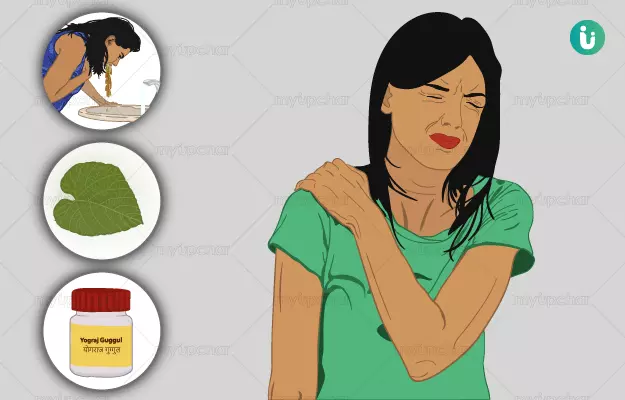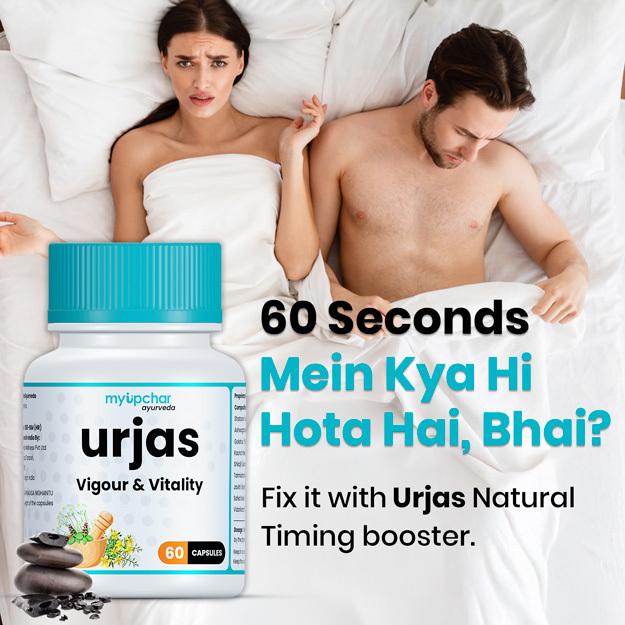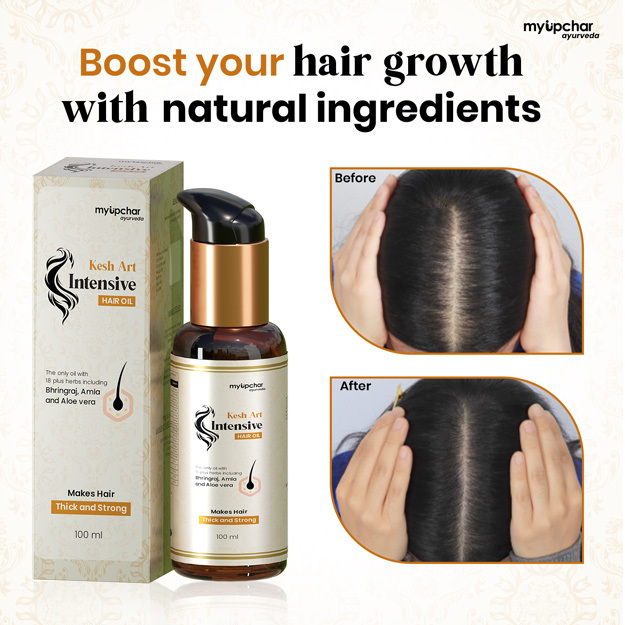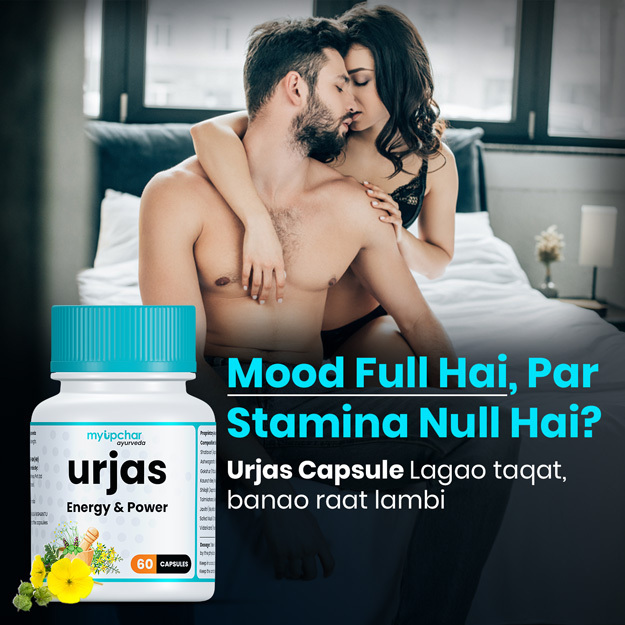Pain, commonly known as shula in Ayurveda, is a symptom that can affect different parts of the body such as the neck, back, pelvis, stomach, chest, nerves, muscles, joints, leg, foot, knee and head. Pain that affects the entire body is referred to as angamarda in Ayurveda. Common causes of pain include overexertion, sprains, and fractures. It may also occur due to underlying conditions like gouty arthritis, rheumatoid arthritis, osteoarthritis, sciatica, diabetic neuropathy, trigeminal neuralgia, shingles, and heel spur. Treatment of pain depends on its underlying cause.
Ayurvedic treatments such as snehana (oleation), swedana (sudation or sweat therapy), nasya (nasal insufflation), vamana (medical emesis), virechana (purgation), basti (enema) and raktamokshana (bloodletting) are recommended for the treatment of pain. Some of the herbs and medicines that are useful in the management of pain are eranda (castor), guduchi (heart-leaved moonseed), brihati (bari katheri), meshashringi (gudmar), shallaki (Indian frankincense), simhanada guggulu, yogaraja guggulu, dashmoola kashaya, bruhadvatachintamaṇi rasa and laksha guggulu.
- Ayurvedic view of pain
- Ayurvedic treatment for pain
- Ayurvedic herbs and medicines for pain
- Dietary and lifestyle changes for pain patient as per ayurveda
- How effective are ayurvedic medicines and treatments for pain
- Side effects and risks of ayurvedic medicine and treatments for pain
- Takeaway
Ayurvedic view of pain
According to Ayurveda, aggravated vata is the primary cause of all types of pain. It may or may not be associated with kapha and pitta vitiation. Vitiation of other doshas can also lead to vitiation of vata and cause pain. e.g., vitiation of pitta and kapha obstructs the movement of vata, leading to pain. Accumulation of ama also causes obstruction in the normal flow of vata and causes pain.
Alternatively, pain may occur as an associated symptom of various health conditions. These include- vataja pandu (iron-deficiency anaemia), amavata (rheumatoid arthritis), sandhivata (osteoarthritis), vata rakta (gouty arthritis), gridhrasi (sciatica), jwara (fever), heel spurs, inadequate blood supply to the back and leg region leading to claudication, sirakautilya (varicose veins), osteoporosis and fractures.
Ayurvedic treatment for pain
- Snehana
- Snehana involves the use of herbal oils for topical lubrication to relieve pain.
- It oleates the body externally and is one of the preparatory steps for panchakarma (five therapies) procedures.
- Snehana helps pacify vata and is thus one of the most useful therapies for pain relief.
- It also, liquefies and mobilises ama (toxins), improves blood circulation and reduces joint and muscle stiffness.
- Abhyanga (oil massage) is one of the methods of snehana that are used to relieve pain.
- Swedana
- Swedana involves the use of heated metal objects, warm hands, steam or heated cloth to induce sweating.
- It liquefies and dislodges ama from different sites in the body and mobilises them to the digestive tract from where it can be easily expelled out of the body.
- Swedana is used as primary therapy for vata-dominant diseases.
- It relieves stiffness and heaviness in the body and is also effective in reducing pain.
- Nasya
- Nasya involves the instillation of herbs in the form of oils into the nasal cavity.
- As nose is the path to the head, nasya is one of the recommended therapies for the treatment of headache.
- It is also useful in the management of migraine, earache, headache, stiff neck and jaw, cough, and tonsillitis.
- Vamana
- Vamana is an Ayurvedic therapy, in which, different herbs are administered to induce vomiting.
- It helps eliminate all the contents of stomach including the accumulated ama, morbid kapha and pitta.
- Vamana is also effective in removing the pathological kapha. It clears body channels, which corrects the movement of vata.
- Different herbs are used to induce emesis in vamana karma, depending on the disease condition and individual tolerance, e.g., pippali (long pepper) can be given to individuals with cough and bronchial asthma to eliminate aggravated kapha. Elimination of aggravated kapha also helps in the treatment of indigestion.
- Virechana
- In this procedure, various medicinal herbs are administered to induce purgation. It is primarily used to eliminate increased pitta.
- Virechana can also be used to eliminate other vitiated doshas and ama from the body.
- It is especially helpful in treating rheumatoid arthritis, an autoimmune condition associated with pain and swelling in joints.
- Basti
- Basti is an ayurvedic form of enema, in which, medicated oils and decoctions of herbs are introduced into the intestine through the rectal route.
- It helps in cleansing the bowel and eliminating ama and aggravated doshas from the body.
- This procedure is effective in the management of gastrointestinal, joint and neuromuscular disorders.
- Raktamokshana
- Raktamokshana is a bloodletting process, which involves the removal of toxic blood from different sites in the body by using metallic instrument or with the help of leeches, cow’s horn or dried bitter gourd.
- It is primarily recommended for the treatment of vata and pitta conditions.
- Raktamokshana also helps in eliminating aggravated doshas and ama thereby relieving pain.
Ayurvedic herbs and medicines for pain
Ayurvedic herbs for pain
- Eranda
- Eranda acts on the urinary, nervous, female reproductive, and digestive systems and has pain-relieving, soothing, and laxative properties.
- It destroys the aggravated and morbid vata and relieves pain and swelling when applied topically. It is very effective in inducing purgation when taken orally.
- Eranda can be used in the management of arthritis and sciatica.
- It is known as the “king of vata disorders” as it is effective in treating most vata diseases.
- Guduchi
- Guduchi acts on the circulatory and digestive systems and is one of the major immune-boosting herbs.
- Guduchi purifies blood and promotes overall strength. Therefore, it is effective in the management of acquired immunodeficiency syndrome (AIDS), cancer, gout, rheumatoid arthritis, tuberculosis, and chronic malarial fever. These conditions may be the underlying cause of weakness and pain in different parts of the body.
- Guduchi can be used in the form of extract or powder.
- Brihati
- Brihati acts on the respiratory, urinary, circulatory, and reproductive systems and has astringent, aphrodisiac, carminative (relieves flatulence), cardiac tonic, and diuretic properties.
- It is effective in the management of cough, asthma and chest pain.
- It relieves gas and is thus useful in the treatment of abdominal pain caused by flatulence.
- Brihati can be used in the form of a powder or decoction.
- Meshashringi
- Meshashringi acts on the urinary, circulatory, and reproductive systems and is one of the main herbs used in the treatment of diabetes mellitus.
- It is also used to treat conditions like fever, cough and swollen glands. Treatment of these conditions can help prevent and treat diabetic neuropathy and body pain caused by diabetes and fever, respectively.
- Meshashringi can be taken in the form of decoction or powder.
- Meshashringi leaves should be taken with caution as they have a stimulating effect on the heart.
- Shallaki
- Shallaki relieves inflammation, stiffness and pain in the joints and bones, which makes it effective in the treatment of arthritic conditions.
- It pacifies aggravated vata dosha and is helpful in the management of various conditions caused by increased vata.
- This herb is well known for its strengthening properties. It strengthens bones and joints and also has anti-inflammatory and cardioprotective properties.
Ayurvedic medicines for pain
- Simhanada guggulu
- Some of the ingredients of this medicine are amalaki (Indian gooseberry), vibhitaki (belleric myrobalan), shuddha guggulu (pure resin of Indian bdellium-tree), haritaki (chebulic myrobalan), shuddha gandhak (pure brimstone) and eranda moola (castor roots).
- This formulation is effective in reducing arthritis pain.
- Simhanada guggulu helps stimulate the digestive fire, which, in turn, improves digestion of ama and lowers the production of kapha.
- It also removes blockages in circulatory channels.
- Yogaraja guggulu
- Yogaraja guggulu is a polyherbal formulation prepared from chitraka (leadwort), vidanga (false black pepper), pippalimoola (long pepper roots), twak (cinnamon), parsika yavani (stinking nightshade), rasna (Indian camphorweed), gokshura (small caltrops), guduchi, guggulu (resin of Indian-bdellium tree), shatavari (hundred roots) and various other herbs.
- It is effective in the management of all types of vata disorders and is especially recommended for the treatment of rheumatoid arthritis.
- Mahayogaraja guggulu, a variation of this formulation advisable for the treatment of chronic rheumatoid arthritis.
- Yogaraja guggulu also pacifies vata dosha and eliminates ama, which makes it effective in the treatment of gouty arthritis.
- Dashmoola kashaya
- Dashmoola kashaya is a liquid formulation prepared from shaliparni (tick clover), kashmari (Malay beechwood), prishniparni (kalshi), agnimantha (headache tree) gokshura and various other herbs.
- It is primarily used in the treatment of vata disorders but can also be used to balance other deranged doshas.
- This formulation helps treat conditions such as stiffness and pain of the neck and back, asthma and cough.
- It is effective in the management of most conditions caused by anubandhya vata, paratantra vata and avrutta vata (types of vitiated vata), which involve the vitiation of vata by ama and other doshas. As vata is the main dosha involved in pain induction, dashmoola kwatha can be used in the treatment of pain.
- Bruhadvatachintamaṇi rasa
- Bruhadvatachintamaṇi rasa is prepared from bhasmas (calcined preparations) of raupya (silver), lauha (iron), abhraka (mica), pravala (red coral) and suvarna (gold), which are then infused with the properties of kumari (aloe).
- It is used to treat all types of vata diseases like slipped disc and osteoarthritis.
- This medicine can also assist in the treatment of conditions like siragatavata, which occurs when imbalanced vata affects the channels and blood vessels of the body.
- Laksha guggulu
- Some of the major constituents of this formulation include laksha (lac), ashwagandha, nagabala (snake mallow), asthisanharaka (veldt grape), arjuna and guggulu.
- Laksha guggulu relieves stiffness, pain and tenderness in joints.
- It also helps in the treatment of local crepitations and oedema.
- The ingredients used to prepare this medicine have pain-relieving, bone-healing, and tissue repairing and regenerative properties, which make it an effective medicine in treating various painful conditions.
As treatments vary based on numerous factors and an individual’s prakriti (constitution), you should consult a qualified Ayurvedic doctor for the appropriate medications and treatments for your specific complaints.
Dietary and lifestyle changes for pain patient as per ayurveda
Do’s
- Include barley, old rice (shali), mudga (green gram) and masura (red lentils) in your diet
- Include fruits like pomegranates and grapes in your regular meals
- Opt for easily digestible food
- Expose your skin to sufficient sunlight
Don’ts
- Do not suppress natural urges like thirst, hunger, and the urge to evacuate the bowel and bladder
- Avoid heavy meals, overeating and eating frequently
- Avoid physical exertion
How effective are ayurvedic medicines and treatments for pain
A comparative clinical study including 24 amavata patients, reported the effectiveness of simhanada guggulu and shiva guggulu in relieving angamarda.
The participants were divided into two groups; one group was treated with simhanada guggulu and the other with shiva guggulu. The same dose and duration of treatment were given to both groups, i.e., 6 g per day for 8 weeks. By the end of the study, symptomatic improvement was noted in both the groups but simhanada guggulu was found to be better than shiva guggulu in treating the condition and relieving symptoms like body pain, loss of interest in food, laziness and heaviness.
Side effects and risks of ayurvedic medicine and treatments for pain
Ayurvedic herbs and treatments don’t really have any side effects, when taken in the right dosage, under the supervision of an experienced practitioner. However, depending on individual body constitution and disease condition these medicines may have serious effects on certain individuals. An Ayurvedic doctor considers all these factors before prescribing a medicine. Needless to say self-medication with any herb, medicine or ayurvedic therapy is not safe. Let us have a look at some of the common contraindications associated with some ayurvedic therapies and medicines
- Nasya is not given to individuals with acute fever
- Virechana is not advisable in children, weak and elderly individuals, and pregnant women
- Individuals with intestinal obstruction or perforation, anal inflammation and anaemia should not undergo basti therapy
- Raktamokshana is not recommended for chlidren, elderly individuals, pregnant and menstruating women. It is not advisable in case of anaemia or leukaemia.
Takeaway
Pain is a common symptom that can occur due to various underlying conditions. Conventionally over- the- counter analgesics are used to provide immediate relief from pain, but the pain relapses as soon as the effect of the medication is over, which makes treatment of the underlying cause necessary. Ayurvedic therapies don’t just suppress the pain but they also treat the cause of the pain. Ayurvedic herbs and medicines strengthen your body and immune system, thus providing permanent and long-term relief from pain.
Find Ayurvedic Doctor in cities
Doctors for Ayurvedic medicine, treatment and remedies for Pain

Dr. Ayush Bansal
Ayurveda
2 Years of Experience

Dr. Megha Sugandh
Ayurveda
6 Years of Experience

Dr. Nadeem
Ayurveda
3 Years of Experience

Dr.Ashok Pipaliya
Ayurveda
12 Years of Experience
References
- Department of Ayush, Govt. of India. Standard Treatment Guidelines in Ayurveda. Centre council of Indian Medicine.
- Dr. Suraj Rubab Shaikh. A CASE STUDY ON AGNIKARMA IN CALCANEAL SPUR (ASTHISNAYUGATA . Department of Shalyatantra; Pune
- Kalapi Patel et al. Effect of Atibalamula and Bhumyamalaki on thirty-three patients of diabetic neuropathy. Year : 2011 Volume : 32 Issue : 3 Page : 353-356
- Dr. Chhavi Gupta et al. TRIGEMINAL NEURALGIA: A CASE STUDY IN AYURVEDIC SETTINGS. Department of kayachikitsa; Rajasthan
- Yi Lai Yong et al. The Effectiveness and Safety of Topical Capsaicin in Postherpetic Neuralgia: A Systematic Review and Meta-analysis. Front Pharmacol. 2016; 7: 538. PMID: 28119613
- The Johns Hopkins University. Foot Pain and Problems. [Internet]
- Dr.Praveenkumar H Bagali. EFFECTIVENESS OF AYURVEDIC TREATMENT IN GRADRASI (SCIATICA): A CASE STUDY. Department Of Kayachikitsa Ayurveda Mahavidyalaya; Karnataka
- Dr. Suresh N Hakkandi. CONCEPTUAL STUDY ON THE MANAGEMENT OF VATAKANTAKA. PIJAR/September-October-2018/Volume-3/Issue-1
- Sanjeev Sarmukaddam et al. Efficacy and safety of Ayurvedic medicines: Recommending equivalence trial design and proposing safety index. Int J Ayurveda Res. 2010 Jul-Sep; 1(3): 175–180. PMID: 21170211
- National Institute of Ayurveda. Post-Graduate Course – Ayurveda Vachaspati(MD(Ay.)/Ayurved Dhanwantary (MS(Ay.). Ministry of AYUSH, Govt. of India
- Kshipra Rajoria et al. Clinical study on Laksha Guggulu, Snehana, Swedana & Traction in Osteoarthritis (Knee joint). Ayu. 2010 Jan-Mar; 31(1): 80–87. PMID: 22131690
- Department of Ayush, Govt. of India. Standard Treatment Guidelines in Ayurveda. Centre council of Indian Medicine.
- Sanjay Kumar Gupta et al. Management of Amavata (rheumatoid arthritis) with diet and Virechanakarma. Year : 2015 Volume : 36 Issue : 4 Page : 413-415










